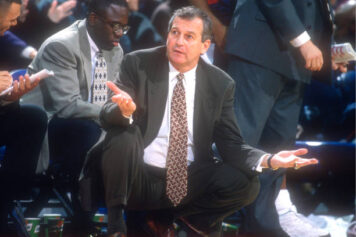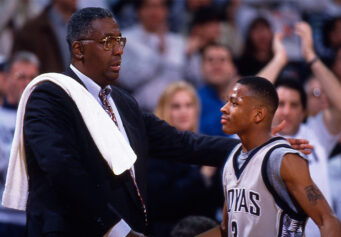I loved watching the ESPN 30-for-30 documentary, “Requiem for the Big East.” The nostalgia and waves of childhood memories that came flooding back were almost overwhelming.
One of my favorite statements was uttered by ESPN’s Mike Wilbon, who said something along the lines of, “You can’t write the first sentence of the Big East without mentioning Pearl Washington.”
We’ve spent the last few weeks talking about our Tourney Titans and now, I’d like to open another room in the chamber. Pearl Washington’s NCAA Tournament legacy, unfortunately, is losing to David Robinson and the Naval Academy in 1986. But if you think his postseason legacy is defined by that, you obviously didn’t watch the Big East Tournament from ’83 to ’86.
You really have to dig in the crates to pull out some of his underappreciated masterpieces, like the Big East Tournament MVP performance during his junior year, the back-to-back 35 point games he detonated on St. John’s, the mesmerizing battles against one of the best defensive teams ever in Georgetown, or the electric 20-point and 14-assist jewel in the Big East Tourney Championship in 1986.
In 1984, when the plague of crack-cocaine was beginning its reign as the most sinister, destructive force on the inner-city family unit and when Whodini was snapping necks with “Five Minutes of Funk,” Pearl, along with Georgetown’s Patrick Ewing, were the foundation of a college basketball and cultural reformation that would leave an undeniable commercial and stylistic footprint that still resonates today.
“[Pearl] was god’s gift to Syracuse,” his college teammate Herman ‘Tree’ Harried told me. “They didn’t start packing that Carrier Dome with 35,000 people until he got there. And he was the most pleasant, special person—very caring, sharing and giving. He wasn’t the flamboyant type that came in the locker room and said, ‘I’m giving Georgetown 30 today!’ He just went out and did it.”
Pearl’s asphalt honed shake-n-bake repertoire included the killer crossover that later inspired Tim Hardaway, Allen Iverson and countless others. The massive Carrier Dome was splattered with t-shirts that read “And on the eighth day, God created Pearl” for every home game.
ESPN should still be flooding Pearl and Ewing with residual checks for how their stylistics and TV ratings, whenever their games were televised, fueled the network’s growth.
Pearl sat down with me a few years back, and I’ve pulled out some gems from that conversation as we reminisce on the teams, moments and players that make March so magical.
What’s your favorite memory of playing out in the New York City parks?
King Towers! I played on a team with Ed Pinckney and Richie Adams. One game we were playing against a team that had Walter Berry, Gary Springer and Steve Burtt. Talk about talent? Those guys were incredible. King Towers, late ‘70s, early ‘80s, those are my favorite memories. I used to go up there and really do my thing.
Can you recall anything specific?
I got to one game late. People started leaving after the first quarter. I rolled into the park on my motorcycle with my girl on the back. I checked into the game and all of a sudden, everybody started coming back into the park. People were everywhere, hanging from trees, watching from the top of the buildings. It was crazy. I remember Richie Adams dunking on Walter Berry and Walter coming back down and dunking on Richie. It was just phenomenal, man. It was fun playing in those tournaments. Those were the best times.
I’d heard that story before about you pulling up late on the motorcycle with a fox on the back and then dropping 55 points. Out of all the incredible talent in the parks, who was that dude that made you say “WOW!”?
Richie Adams! The Animal! He was one of the best. Had he stayed on track, he’d have been very successful in the NBA. But that shows you how tough it is coming up in the city. You have to be focused and careful who you hang around. I didn’t hang around negative people. Guys want to give you money, drugs, women coming at you, whatever. That’s a fact. If you’re not strong enough to understand that and you do things, or take things from people who don’t have your best interest at heart, then you get what you get. Unfortunately, that’s the way it works.
NYC is the mecca of point guards. Who were you going against back then?
The point guard comp was incredible. Kenny Smith and Kenny Hutchison were two of the best. I played against them a lot because they played for Riverside Church, the Gauchos’ main rival. Mark Jackson was doing his thing too. Rod Strickland was a little younger than me, but he was coming up strong. Steve Burtt, All Day, was a little ahead of me and he was phenomenal.
Out of those guys, who gave you the most problems in the park?
None of ‘em. I gave all of them fits.
Why did you choose to play at Syracuse? At the time, they weren’t a top program that the best players wanted to play for.
They didn’t have anybody that I had to worry about at the point guard position; not that that would have made a difference anyway. I wanted to major in communications and they have an excellent communications department. They were in the Big East, the best conference. I knew I’d be on TV a lot playing against the best. The Carrier Dome had just been built and no other place had a stage that big. And, I’d be coming home to Madison Square Garden to play St. John’s and in the Big East Tournament.
What happened your freshman year?
I was killin’ ‘em straight out the gate. You have to understand that every game I ever played, going back to elementary school, was important to me because I had a name, a reputation. I wasn’t going to let anybody come at me and get one up on me. I didn’t care who it was. You were gonna get it. Bottom line!
As a freshman, you tore Georgetown’s press to shreds in the Big East finals and you put Gene Smith, a great defensive guard, on his hind parts. They were considered one of the greatest defensive teams ever. What did that feel like?
Do you realize how exciting that was for me? That was THE BEST! My best memories from college were playing against Georgetown and St. John’s. I used to kill them, especially in the Garden. I remember being pressed, shaking Gene Smith, getting by Reggie Williams and two other defenders. It was just a one-on-one situation with me and Patrick Ewing. I went straight at him, down the middle, and laid him.
He didn’t even jump to try to block my shot and he wasn’t in foul trouble. I guess he was more amazed at what he’d seen back there, how I boogied through all of his guys. And even if he jumped, I don’t know what I would’ve done but that ball was going in the basket.
What was it about St John’s and playing in The Garden? To this day, those are, in my mind, the most incredible collegiate performances I’ve ever seen.
Madison Square Garden was my real home. It was magic. When I played there, oh, it was showtime. I had to make it happen in The Garden. I remember the back-to-back 35-point games against St. John’s my junior year but the one that still stands out in my mind is the one-point loss to them in the Big East Finals that year. I just felt so bad because I knew that was it for me. I knew New Jersey was going to draft me. It was already a done deal.
Looking back now, would you have stayed for your senior year instead of coming out early?
Absolutely! I made a mistake. College was so much fun. Pro ball was a job. When it became a job, it stopped being fun and I lost my love for the game. I should have stayed and given myself to the opportunity to play with Derrick Coleman and I would’ve gone much higher in the draft, maybe top five.
The crossover got huge with Tim Hardaway, but he said he learned it by watching you at Syracuse. When did you first start shaking cats with the crossover?
That was something that worked for me growing up. I played out in the parks and developed that weapon on the streets to get by people. As a point guard, that’s what you do—find a way to get through and start your offense. Once you get by people, the D has to help so you can either dish off or go to the basket yourself. I don’t think I created the crossover. It was just something that I did, something that I made up for me in the laboratory of the New York City playground.



